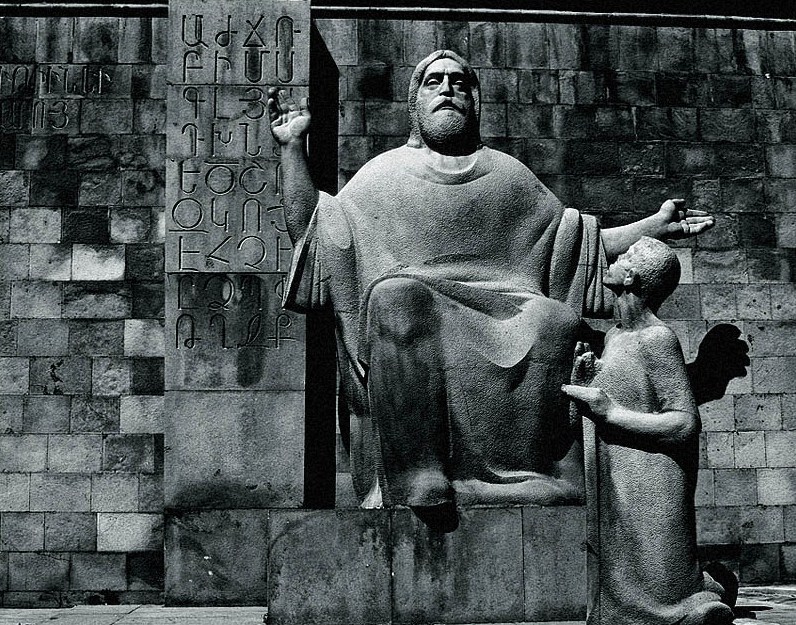One of the greatest milestones in Armenian history was the invention of the Armenian alphabet in 406 A.D. It was a turning point that offered a new character to Armenian civilization.
Before the fifth century, although Armenians had a vernacular, everyday spoken language, they did not have an alphabet and could not write in their own language. They used the alphabets of neighboring countries to record historical events and official documents. They had to use alien letters to express themselves.
Before the invention of the Armenian alphabet, Armenians were also constrained in the practice of their religion. They had to use the Syriac and Greek languages in their worship services and in their liturgies. The Bible was read and hymns were sung in these foreign languages. They were yet to be translated into Armenian. Thus, the worshiping congregations remained illiterate.
In 387, Armenia was divided between the Byzantine and Sassanid empires. Both of these superpowers pursued a policy of assimilating the Armenians and gradually eliminating their culture. The internal situation was equally dangerous because of the disunity of the Armenian nobles.
In this critical period, divine providence granted Armenia three titanic personages: Catholicos Sahag Bartev (389-439), Priest St. Mesrob Mashdots (361-440) and King Vramshabouh. This dedicated trio initiated a cultural revolution and brought forth a new, uniquely Armenian civilization.
King Vramshabouh and Catholicos Sahag realized that in order to maintain some religious and political control over the partitioned nation and preserve and perpetuate the cultural and spiritual heritage, there had to be a unifying factor. They decided that this decisive factor would be the Armenian language. They believed language is a strong indicator of a people’s culture.
The problem, however, was that although Armenians had a language, they did not have an alphabet. The king and the catholicos decided to commission one of the most erudite intellectuals in Armenia, Mesrob Mashdots, to invent an Armenian alphabet. Mesrob, formerly a royal secretary, had become a monk. He was an expert in the Greek, Syriac and Persian languages. In his intensive search for an alphabet, he learned that an Assyrian bishop named Daniel was in possession of an Armenian alphabet from ancient times. After putting this alphabet to the test, Mesrob found it inadequate and flawed, because it had no vowels and would not satisfy the sound symbols of the Armenian vernacular language.

For several years, Mesrob traveled to the cultural centers of the Near East and experimented with sets of variations. Finally in 406, he developed a type of letters that would satisfy the phonetic complements and sound systems of the Armenian language. He created a set of 36 characters (two more letters were added in the 12th century). Following the invention of the Armenian alphabet, foreign languages were removed from Armenian churches, schools were opened and a nationalistic atmosphere of hope filled the life of the Armenian people.
After the creation of the Armenian alphabet, by order of King Vramshabouh, around 100 intelligent and promising youth and young adults were recruited from every region of Armenia. They learned the Armenian alphabet from St. Mesrob and were trained in Armenian studies. They were also sent to Athens, Caesarea, Byzantium, Edessa, Antioch and Alexandria to become fluent in the Greek and Assyrian languages and scholarship.
These students brought back to Armenia not only mental storehouses but also numerous manuscripts, which they began to translate into Armenian under the patronage of St. Sahag and St. Mesrob. Of these students, those who would become the most famous were Goriun (Koriun) the Wondrous, Yeznig (Eznik) of Goghp and Moses of Khorene (Khorenatsi). These, and other scholars, were named by their posterity the Holy Translators.
With the invention of the alphabet, the Holy Translators began to translate the Bible. The translation was made from the Syriac and Greek versions. The Armenian translation was first based on the Syriac version and later revised on the basis of the Septuagint, the Greek version of the Old Testament.
The Holy Translators were stirred to put into writing their knowledge of theology, history, law, philosophy and liturgics. They translated the important writings of the then civilized world. A cultural renaissance took place in the fifth century, which later generations called the Golden Age.
By inventing the Armenian letters, St. Mesrob Mashdots not only secured a victory for Christianity in Armenia, but he also put a valuable tool in the hands of the Armenian people with which they could form their unique culture. From that day forward, the Armenian people had their own intellectual life and knowledge and learning became the property of the Armenian people as a whole. This also became a powerful means of national preservation and unity.



Be the first to comment